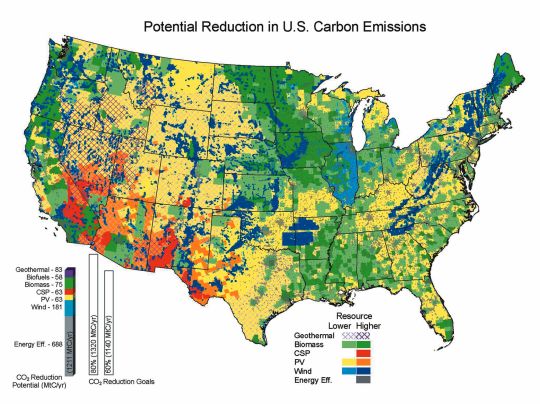A new piece of conventional wisdom is rapidly congealing among mainstream pundits: global warming is happening, but there’s nothing we can do about it. Might as well just batten down the hatches and hope for the best.
You’ll hear the same basic message from Fareed Zakaria, Washington Post columnist Robert Samuelson, Newsweek columnist George Will, and a number of other mandarins of center-right establishment opinion.
Let’s be clear: This proto-conventional wisdom is wrong. There’s plenty we can do about global warming.
 What would it mean to do something serious about climate change? Scientists tell us that to stabilize atmospheric greenhouse gases at between 450 and 550 parts per million CO2 equivalent — a level sufficient to avoid unstoppable, irreversible changes — we’ll need to reduce global GHG emissions by around 80% by 2050. (Obviously all these figures are approximations, and could move up or down with future study.)
What would it mean to do something serious about climate change? Scientists tell us that to stabilize atmospheric greenhouse gases at between 450 and 550 parts per million CO2 equivalent — a level sufficient to avoid unstoppable, irreversible changes — we’ll need to reduce global GHG emissions by around 80% by 2050. (Obviously all these figures are approximations, and could move up or down with future study.)
That sounds like a huge task, and if you’re trapped in a bubble of conventional thinking, you’ll likely throw your hands up in despair. But there are several plans and programs on the table that claim to be able to meet that goal — without sparking a global economic recession, and without relying on coal or nuclear power.
Energy [R]evolution is a report developed by Greenpeace and the European Renewable Energy Council (EREC) “in conjunction with specialists from the Institute of Technical Thermodynamics at the German Aerospace Centre (DLR) and more than 30 scientists and engineers from universities, institutes and the renewable energy industry around the world.” Here’s the summary:
Renewable energy, combined with efficiencies from the ‘smart use’ of energy, can deliver half of the world’s energy needs by 2050, according to one of the most comprehensive plans for future sustainable energy provision, launched today. The report … provides a practical blueprint for how to cut global CO2 emissions by almost 50% within the next 43 years, whilst providing a secure and affordable energy supply and, critically, maintaining steady worldwide economic development. Notably, the plan takes into account rapid economic growth areas such as China, India and Africa, and highlights the economic advantages of the energy revolution scenario. It concludes that renewable energies will represent the backbone of the world’s economy — not only in OECD countries, but also in developing countries such as China, India and Brazil. “Renewable Energy will deliver nearly 70% of global electricity supply and 65% of global heat supply by 2050.”
Another hopeful report is called “Tackling Climate Change in the U.S.: Potential U.S. Carbon Emissions Reductions from Renewable Energy and Energy Efficiency by 2030.” It all started when …
… a year-and-a-half ago the American Solar Energy Society recruited a team of volunteer energy experts. We did not give them any targets to aim for. We merely asked them to estimate how much their technologies could reduce carbon emissions by the year 2030 if they were deployed as part of a highly aggressive national effort to combat global warming.
The experts produced a series of nine papers. Three of them examined the potential carbon emissions reductions from energy efficiency opportunities in buildings, transportation, and industry. The other six covered renewable energy technologies: biofuels in the form of cellulosic ethanol to replace gasoline, and electric power production from wind, concentrating solar, roof-mounted photovoltaics, biomass, and geothermal.
The 200-page report being released today — Tackling Climate Change in the U.S. — is the culmination of this effort. The results show that we have a variety of promising means available to battle global warming. They indicate that energy efficiency measures can prevent our carbon emissions from growing over the next 23 years, even as our economy grows. The six renewable technologies have the potential to make the kind of deep cuts needed in our carbon emissions. Of the total carbon reductions possible, 57% are due to energy efficiency and 43% are from renewables.

The Sierra Club has adopted this plan as its official energy strategy.
On the legislative side, Sen. Bernie Sanders’ Global Warming Pollution Reduction Act claims it will reduce U.S. GHG emissions 80% from 1990 levels by 2050. In the House, Henry Waxman’s Safe Climate Act does roughly the same.
In other heartening news, an extensive piece in the Wall Street Journal details how costs are falling for clean energy and soon will be competitive with dirty energy. Imagine what could be done on the clean energy front if instead of spending $1.2 billion a year on renewable energy research, the feds borrowed, say, $50 billion from the defense budget. Imagine if America mobilized with the same zeal and unity of purpose it’s brought to previous challenges.
None of this settles the argument of whether aggressive emissions targets are reachable in a way that won’t hurt the economy. I think it’s possible; others disagree.
The point is just that we don’t have to accept the casual, unthinking fatalism Beltway "centrists" are currently trying to urge on us. It’s far, far from a settled question.

